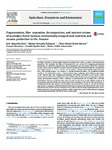Please use this identifier to cite or link to this item:
http://www.alice.cnptia.embrapa.br/alice/handle/doc/1014295| Title: | Fragmentation, fiber separation, decomposition, and nutrient release of secondary-forest biomass, mechanically chopped-and-mulched, and cassava production in the Amazon. |
| Authors: | REICHERT, J. M.  RODRIGUES, M. F.   BERVALD, C. M. P.   BRUNETTO, G.   KATO, O. R.   SCHUMACHER, M. V.   |
| Affiliation: | José Miguel Reichert, UFSM; Miriam Fernanda Rodrigues, UFSM; Clóvis Moisés Priebe Bervald, GSI BRAZIL; Gustavo Brunetto, UFSM; OSVALDO RYOHEI KATO, CPATU; Mauro Valdir Schumacher, UFSM. |
| Date Issued: | 2015 |
| Citation: | Agriculture, Ecosystems and Environment, v. 204, p. 8-16, June 2015. |
| Description: | No-tillage planting in mechanically-chopped secondary-forest seeks to replace slash-and-burning agriculture. We evaluated the effect of horizontal (HC) and vertical (VC) chopping-and-mulching mechanisms on vegetation fragmentation and decomposition rate and nutrient release from chopped residue, and on cassava production in eastern Amazon. Chopped-and-mulched residue was classified into four residue-size (Fs1 = 1?7, Fs2 = 7?25, Fs3 = 25?35, and Fs4 = >35 mm) and six residue-type (with husk/bark ? WB, partially chopped ? PC, compact ? C, partially shredded into fibers ? PS, completely shredded into fibers ? CS, and formless residue ? F) classes. In litter-bags, residual dry matter (DM) was determined at five different days after chopping-and-mulching and residue distribution on soil surface (DAD), whereas release of N, P, K, Ca, and Mg was evaluated at four days. Residues-size and -type classes showed similar decomposition behavior, with a reduction of approximately 60% of initial DM at 90 DAD. Nevertheless, reduction in DM was slow, where 52 days are necessary for half of labile residue to be decomposed, with part of labile and recalcitrant residue remaining on soil surface. DM and nutrients in residue reduced over time. DM was 25% for residues-size classes for HC, 20% for VC, and 26% for residue-type classes, on average, at 300 DAD. Nutrients remaining in residues at 300 DAD were 26% and 27% of N, 26% and 22% of P, 29% and 22% of K, 16% and 15% of Ca, and 17% and 23% of Mg, respectively for HC and VC. Release of nutrients was, generally, greater for smaller residue-size classes, similar between chopping-and-mulching mechanisms, and did not affect cassava yield. |
| Thesagro: | Biomassa Floresta Mandioca Solo Vegetação |
| NAL Thesaurus: | Amazonia |
| Keywords: | Corte mecanizado Propriedade química |
| DOI: | http://dx.doi.org/10.1016/j.agee.2015.02.005 |
| Type of Material: | Artigo de periódico |
| Access: | openAccess |
| Appears in Collections: | Artigo em periódico indexado (CPATU)  |
Files in This Item:
| File | Description | Size | Format | |
|---|---|---|---|---|
| 1s2.0S0167880915000523main.pdf | 1.75 MB | Adobe PDF |  View/Open |









